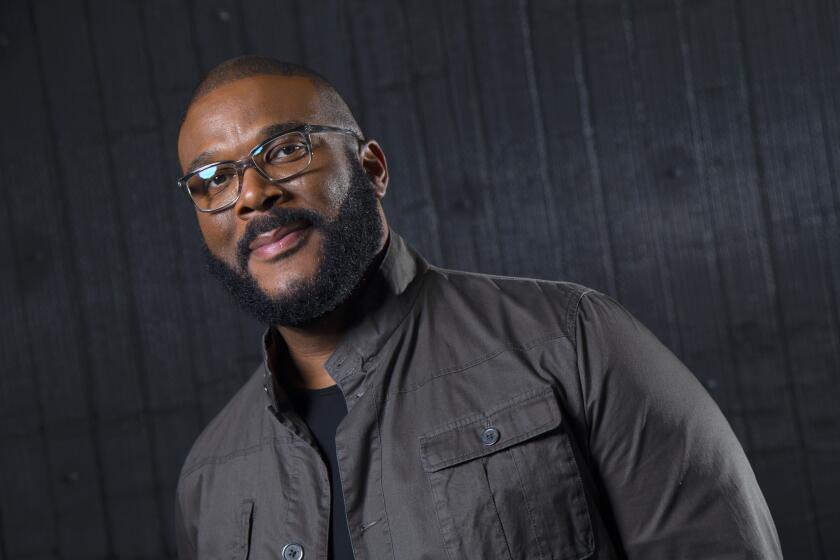Vibrant shadings in ‘Grey Gardens’
- Share via
By all laws of art and nature, “Grey Gardens” should be dead by now, a dried-up husk leeched of all creative possibility.
The story of Edith Bouvier Beale and her daughter, Edie, a pair of former society fixtures found living in nonpicturesque yet strangely joyful squalor in the 1970s, began as a cover story in New York magazine. It went on to become a cult-worshiped documentary, a Broadway musical, a documentary of the making of that Broadway musical and now a movie on HBO. Surely someone should just write the “Grey Gardens” symphony and be done with it.
Well, two someones, namely screenwriters Michael Sucsy (who also directed) and Patricia Rozema, have. Anchored by amazing performances by Jessica Lange and Drew Barrymore, the “Grey Gardens” that premieres tonight is, like its subjects, a brilliant, moving, hilarious and mesmerizing mess of a movie that miraculously captures what made the Beales such iconic characters.
That’s a lot of adjectives, but “Grey Gardens” is a lot of movie.
Lange, we are reminded once again, is an actress who can do anything, anything, including play a bedraggled, gray-haired woman who stands amid piles of rotting garbage and cat feces, looks Jacqueline Kennedy Onassis (a terrific Jeanne Tripplehorn) straight in the eye and says in her most beguiling tones: “You know, chicken, if you ever need a place to stay, you’re always welcome here.”
If Lange was an obvious choice for her role, Barrymore was not. When she was cast as Little Edie, the scarf-swathed, uninhibited, often scathing middle-aged sprite who lighted up Albert and David Maysles’ original documentary, I must confess I thought the project was doomed. Barrymore’s cute and all, but how could she embody a woman who was dancing with an American flag one minute and taking down East Hampton society the next?
Perfectly, as it turns out. Her young Edie has just enough hint of otherworldliness and self-delusion to make her later Edie completely believable, and the Barrymore twinkle makes the occasional glimpses of Edie’s tamped-down sadness even more affecting.
In other, less loving and capable hands, this strange symbiotic relationship between mother and daughter could easily have become a typical mama-dominatrix trope. Here, as in the documentary, it is something more startling: an orchid growing in the shade and rot of the forest floor, a fragile ecosystem threatened by more modern-minded developers.
With flashbacks and a seemingly double-pronged timeline that is often confusing, “Grey Gardens” follows the Edies through the various stages of their lives. We see the heady society days when Big Edie, much to the disgust of her husband, Phelan (Ken Howard), used Grey Gardens as a theater in the round for her thwarted musical career and pushed her daughter to marry rich.
With her devoted “accompanist” Gould (Malcolm Gets) by her side, Lange’s Edie is a silken sundae of fraying glamour, a self-sustaining if slightly insubstantial creature who might have wandered out of a Tennessee Williams play after she discovered how rough Williams could be on his women.
Barrymore’s Edie loves her father but she worships her mother, and longs to be a dancer and actress. She talks big about rejecting the marry-a-rich-boy goal of her class to find independence, but while she does the former, she never achieves the latter. According to the narrative of the film, a badly ended affair with a married man sends her back to the sweet suffocation of Grey Gardens, never to emerge again.
That, by the way, is all the explanation you’re going to get. Why the Beales withdrew so entirely, why they never pulled themselves together and put the brakes on their slow slide into decay is not explained. The isolated days, like the dishes and the cats and the cracks in the walls, simply accrued until the women’s lives were overrun.
So when the Maysleses, who originally were doing a documentary about the Bouviers, met them, it was artistic love at first sight.
Those who are familiar with previous incarnations of “Grey Gardens” will recognize many of the scenes and famous lines, but the film is far more than a dramatic remake.
Lange and Barrymore, through skill and presence, infuse their characters with glamour in the true dissociative sense of the word. As they sing and dance to their beloved records, as they comment on society and politics, we see the glorious women beneath the rumpled weight of age and gypsy-like clothing, the fey spirits that shine amid the dripping ice cream containers and cat-covered beds.
In scene after scene, the trappings of their surroundings fade away as they must have in the actual lives of the women who lived in Grey Gardens. The raccoons, the piles of newspapers, the holes in the walls -- what did it matter when mother and daughter clearly felt the same, were the same, as they had been when the halls were filled with the cream of East Coast society and their throats and ears were hung with jewels?
How they got there doesn’t matter so much as the extraordinary fact of their existence.
--
‘Grey Gardens’
Where: HBO
When: 8 tonight
Rating: Unrated
More to Read
The biggest entertainment stories
Get our big stories about Hollywood, film, television, music, arts, culture and more right in your inbox as soon as they publish.
You may occasionally receive promotional content from the Los Angeles Times.











